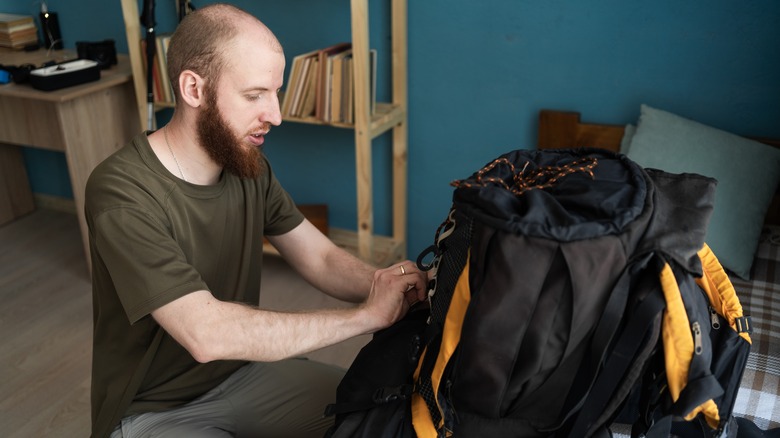
Choosing the best backpack for your next trip? Travel expert Rick Steves has a few thoughts on one of the most popular types of travel bag: the internal-frame backpack. These are designed with rigid stays or rods, often aluminum or carbon fiber, that are built into the pack's structure to rest against the back. They also typically come with a padded hip belt to distribute the weight of the bag from your shoulders to your hips, reducing strain on the upper body by around 30% (via NIH).
According to
Steves' blog, internal-frame backpacks are some of the most comfortable bags to wear, especially for travelers embarking on long hikes or carrying heavy loads. That said, they aren't free of drawbacks.
For starters, they can be pricey — especially high-quality models designed for serious outdoor use. And, unless you're a big hiker, the hundreds of dollars they cost might not be worth it. Additionally, internal-frame backpacks also tend to be taller than the standard size for personal items and even carry-ons on most airlines. So, if you're trying to fly with it, you'll have to pay a fee for it to be treated as a checked bag. Otherwise, you'll probably have to find the nearest luggage store in the airport to look for something smaller and leave the backpack behind. Finally, their size can also make it tempting to overpack and go over airlines' weight limits. And you definitely don't want to risk having to pay those seemingly never-ending overweight fees or having to throw out your valuables.
Read more: How To Pack Just One Carry-On For A Week-Long Vacation
Internal-Frame Backpacks Aren't For Everyone

Before your trip, ask yourself: Am I going to be hiking or walking long distances carrying a lot of weight? Also, is the terrain going to be rocky, unpaved, sandy, snowy? If the answer is yes, an internal-frame backpack could be a worthwhile investment, according to Steves.
However, if you are only heading out for a short city trip, a lighter, soft-sided backpack might be a better option. Also, if you already own a regular backpack you love and want to take it on longer journeys, you can easily purchase a hip belt kit for under $10. Just make sure that your backpack has the appropriate attachment points or loops. If it doesn't, you may need to sew or use adhesive fasteners for a more secure fit. Ultimately, purchasing one of these to upgrade your backpack can mean significant savings, as internal-frame backpacks usually cost from $100 to over $500.
No matter your choice, it's worth noting that the way you distribute the items in your backpack can either stress or alleviate your spine and shoulders. Specifically, placing heavy items closer to the body's center of gravity reduces forward lean and spinal torque. In other words, if the weight sits far from your spine, your muscles work harder to counterbalance it. That said, you'll want to keep water bottles, food, and dense gear against the back, at mid-to-upper back height. Meanwhile, lighter, bulkier gear can go farther out. In the end, you know your body best. And if you're thinking that maybe carrying around a huge backpack with too much weight might do you more harm than good, there's always another option: a smooth carry-on suitcase designed by Rick Steves himself.
Ready to discover more hidden gems and expert travel tips? Subscribe to our free newsletter for access to the world's best-kept travel secrets.
Read the original article on Islands.










